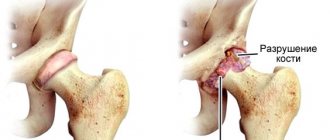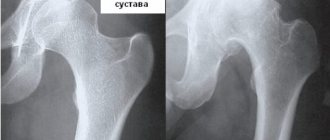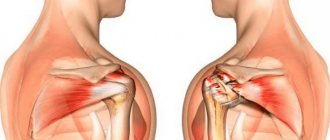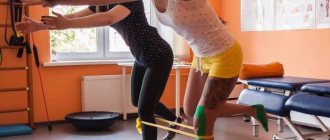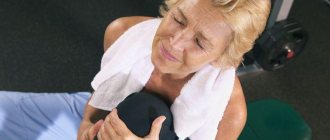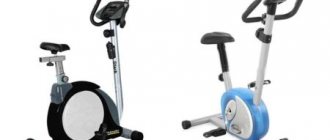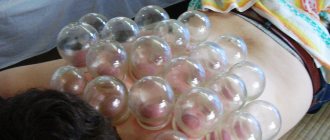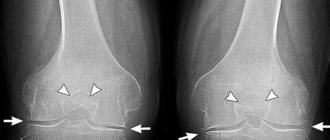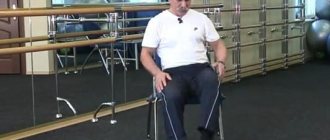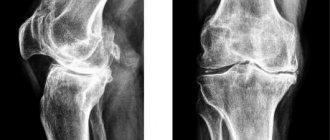For arthrosis of the knee joints, Evdokimenko’s healing gymnastics are considered one of the best. Only a system of complex exercises will help achieve serious results in curing arthrosis. This is especially true for large joints. Exercise therapy Evdokimenko improves blood circulation in the body, strengthens muscles and ligaments, and also saturates cartilage tissue with the necessary amount of nutrients.
Principles of physical therapy complex
Exercises are developed and selected individually for each patient. This largely depends on the location of the affected joint. In addition, it is necessary to take into account the severity of the disease, pathological processes, the presence of complications or other diseases.
If you choose the wrong exercises, the patient’s well-being can significantly worsen. It is recommended to coordinate the complex with a physiotherapist and primary care physician.
Dr. Evdokimenko came up with exercises for all large joints that need to be used for arthrosis. Thanks to an individual approach, taking into account the characteristics of the patient, significant results can be achieved in a relatively short time. At the same time, the risk of side effects is minimal.
Therapeutic gymnastics for arthrosis of the knee joints according to Evdokimenko strengthens muscles and ligaments, tissue trophism, but the patient will not move the damaged joint at all. This is due to increased progression of the disease with direct loads on the diseased joint.
But there may still be pain. As a rule, this is due to the load on muscles that were previously practically not used or loaded. The pain will go away after a few sessions. If there is a sharp pain, then you cannot do the exercises, since when doing it, the sore joint is loaded, and this provokes a worsening of the condition.
But there are times when the exercise itself is suitable for a person, but he performs it incorrectly, which is why sharp pain occurs. Only a doctor in therapeutic exercises can help here, who will show the correct execution.
Physical therapy should only be done during remission. During exacerbations of the disease, gymnastics is strictly contraindicated. The Evdokimenko complex allows you to strengthen not only the periarticular, but also the back and abdominal muscles. One lesson should include 2-3 stretching exercises and 5-7 strengthening exercises. There are quite a lot of them in the complex, so you can do different ones every day. The duration of the lesson is about 20-30 minutes.
No. 1. Is it necessary to follow a diet with arthrosis?
If the disease proceeds as usual, without complications, a diet for arthrosis is necessary. Its main task is the fight against excess weight and a general healing effect on the body. Proper nutrition can slow the progression of the disease.
In short, reduce your consumption of cereals, rice, potatoes, butter and sour cream, completely give up alcohol, carbonated water, refined and canned foods, and nuts. Instead, diversify your diet with fresh green vegetables and lettuce, drink vegetable juices, add vegetable oil, milk, yogurt, and seasonal fruits.
The main principle of a diet for arthrosis is moderation.
Evdokimenko’s gymnastics for the treatment of arthrosis of the hip joints
According to Dr. Evdokimenko, treatment of arthrosis of the hip joint with the help of physical therapy is possible. You may not believe it, but fact is a stubborn thing. Thousands of Pavel Valerievich’s patients got rid of the disease thanks to his technique. But any type of therapy must be approached sensibly, the possibilities must be assessed, and the load must be distributed correctly. Evdokimenko’s healing gymnastics for arthrosis of the hip joints is no exception. Before starting training, you need to get acquainted with the author’s recommendations, contraindications for training and get an individual complex from your doctor.
No. 10. What injections will help with arthrosis?
One of the effective but long-term treatment options for osteoarthritis is injections of chondroprotectors. The active substance acts directly on the problem area, restores cartilage, stimulates its renewal, increases the formation of collagen and mucopolysaccharides, and has a healing effect.
The second option is intra-articular injections of a synovial fluid prosthesis, for example Noltrex. The drug is injected into the joint, where it replaces the missing synovial fluid. The gel covers the damaged cartilage surfaces and pushes them apart. You no longer experience pain or discomfort while moving. The effect is noticeable after 1-2 injections and lasts for 12-18 months.
Synovial fluid prosthesis is already approaching the gold standard for the treatment of arthrosis
If you have other questions about the treatment of arthrosis, do not be afraid to ask your doctor during your routine consultation. This is the only way to get a qualified answer and correctly adjust the treatment regimen.
Information about the doctor
Dr. Pavel Evdokimenko has been practicing medicine for more than 20 years. His specialty is rheumatology and psychophysiology. During his work, the doctor was engaged in teaching activities and developed complex therapeutic techniques for the following diseases:
- poor posture;
- Bekhterev's disease;
- inflammation of the hip joint;
- diseases of the cervical and thoracic spine;
- osteoporosis;
- problems with the meniscus;
- arthrosis of the joints.
Pavel Valerievich has an academic degree - Academician of the AMTS of Russia. He can be seen on television in medical programs, where he appears as an expert on medical issues. Dealing with the problems of treating joint diseases, Dr. Evdokimenko developed a unique technique that is popular among patients.
Who is gymnastics recommended for?
Gymnastics by Pavel Evdokimenko is indicated for those patients who have stiffness and deterioration in the mobility of the joints of the hip bones. Classes are necessary in case of severe destruction in order to prevent prosthetic surgery. Physical therapy gives results for stage 1-2 arthrosis.
Regular and properly selected loads allow you to achieve the following results:
- eliminate pain in the hip joint;
- improve mobility;
- strengthen the muscles of the musculoskeletal system to reduce the load on the joint;
- improve blood circulation in tissues;
- stop the destruction of the hip joint;
- prevent the need for surgical treatment.
90% of patients who use exercise therapy to treat joints according to Dr. Evdokimenko’s method note an improvement in their well-being after a month of regular exercise. 80% of patients claim that training has made them more mobile and resilient. More than 90% of people who do not neglect gymnastics avoid surgery.
Patient mistakes
According to the doctor, treatment of arthrosis without the use of sports activities is ineffective. Patients who neglect physical activity, even when following other recommendations (taking medications, physical procedures), note a deterioration in their condition. Mistakes made by patients in the treatment of joint pathologies:
- at the slightest relief after drug therapy, exercise therapy is ignored due to its “frivolity” or “futility”;
- Trying to speed up the healing process, a person does gymnastics “to the max.” At the initial stage of training, the number of repetitions and the time of static pauses is minimal. Their number should be increased gradually. Doing 100 squats at once will be just as harmful to the joint as doing nothing;
- Correct execution of the complex is possible only under the supervision of an instructor or physiotherapist.
A joint is a complex mechanism. The development of arthrosis destroys its surface. A thoughtless approach to training aggravates the condition of the joint, and the destruction progresses. It is important not just to practice, but also to perform gymnastics under the supervision of a specialist.
Implementation principles
No matter how severe the injury to the knee joint, gymnastic training will always be beneficial for the patient. Physical therapy is not able to cure the affected joint, but it can improve its function, as well as stabilize blood flow and activate muscle tone before surgery. There are two sets of knee exercises.
Of these, 1 part of the training is intended to facilitate movements and relieve pain during conservative treatment. It also serves as an excellent help in preparing the patient for various operations, especially endoprosthetics. And part 2 of the training complex is used for rehabilitation after traumatic ligament damage, as well as to speed up walking in the postoperative period.
The main rules of therapeutic exercises are presented below.
- Regular use. Using any exercise once will not bring any benefit. In addition, when performed dynamically on an untrained knee, it can lead to further impairment of active movements. The first part of the exercises must be performed for at least 3 months, and after surgery on the knee joint - before independent, easy manipulations in the endoprosthetic joint.
- Gradual increase in loads. Exercising too intensely will lead to ligament rupture and muscle strain.
- You can't overdo it. With regular training, 30-40 minutes a day is enough for the full effect of gymnastics.
- Monitoring by medical staff. The beginning of any training is carried out under the supervision of a doctor or exercise therapy instructor. In the postoperative period, the condition of the leg is monitored by rehabilitation specialists, who develop an individual complex of therapeutic effects of dosed physical activity.
- Symmetry. Even if only one joint is affected, both should work fully. This will ensure uniform blood flow and facilitate movement in both limbs.
- Strictly no pain. If exercises cause serious discomfort, you should stop using them. Only an experienced specialist will give further instructions on physical activity. A little pain is not an obstacle to exercise, since straightening the muscles and increasing the range of motion in the injured knee is impossible without it.
Every patient suffering from pathology in the knee joint is recommended to use a set of therapeutic exercises. For mild injuries, training will help to quickly restore the functioning of the joint; for severe injuries, it will ensure the success of postoperative rehabilitation. Although exercise therapy cannot completely cure a knee, it can improve the condition of all muscles and tendons involved in movement.
Healing gymnastics Evdokimenko
It is impossible to list all the exercise therapy exercises developed by the academician. Firstly, there are a lot of them, and secondly, their variations depend on the doctor’s recommendations. We will list only the main ones.
Classes are based on static exercises with a small addition of dynamic ones. People who move little and have not paid attention to physical activity for a long time need to start training gradually. An important requirement for dynamic loads is a slow pace of their implementation. Degenerative-dystrophic pathologies are incompatible with fast movements, sudden swings and large amplitudes. Slow execution is less tiring for the patient, allows you to extend the training time, increase the number of repetitions, which strengthens atrophied muscles, tendons, and ligaments.
How to exercise correctly
Many patients believe that if excessive physical activity accelerates destruction, then it is worth paying attention to gymnastics. This is an erroneous judgment
For gymnastics to be beneficial, you must follow the rules:
- For training, choose those exercises that strengthen ligaments and muscles, giving preference to static loads.
- Dynamic loads should be smooth, without jerking.
- If your physical fitness is poor, you need to start treatment with simple, gentle exercises.
- The goal of Pavel Evdokimenko’s healing gymnastics for arthrosis of the hip joints is to strengthen the muscles and not load the joint.
- Perform stretching exercises slowly, smoothly, with minimal pressure on the affected area.
- Treatment of the hip joint with exercise therapy, in addition to working on the affected area, includes strengthening the back muscles and abs.
- Systematic training to get results.
- Pain during training has two explanations: either the loads are not suitable for the person, or he performs the exercise incorrectly.
- A daily set of exercise therapy classes includes 2-4 stretching exercises, 5-6 strengthening exercises. They can be changed, but the number of repetitions should be maximum. The same load should be given to each limb.
Gymnastics classes only seem simple and easy. To get results you need great willpower, endurance and patience. The first achievements in exercise therapy appear after a month of regular training.
httpv://www.youtube.com/watch?v=embed/ta-Ch__tME
Complex exercise therapy for coxarthrosis
- The person lies down with his stomach down, straightens his legs. Arms extended forward. The patient lifts his limbs up one by one. Lifting height – 15-20 degrees. The raised limb is fixed at the maximum point for 5-10 seconds. The correct pace for performing the exercise is moderate. Returning to the starting position, the patient relaxes the muscles and rests.
- The patient lies on his back. Hands extended along the body. He bends one leg at a right angle, fixes it for 30-40 seconds, then smoothly lowers it. Repeats the exercise 10-15 times. The same goes for the second limb.
- The person lies stomach down, arms extended along the body. At the same time, lifts both limbs off the floor and lifts them up 15-20 degrees. Without bending your knees, spreads both legs to the sides, fixes them for 5-10 seconds, and lowers them. Repeat up to 20 times.
- Lying with his stomach up, a person bends one limb and straightens the other. Feet are tense. The patient changes their position alternately 20 times.
Lifting the limbs from a lying position is performed using the force of the hips and buttocks, the pelvis is pressed to the floor. It cannot be deployed following the raised leg. All movements of the complex are smooth; sharp or high lifts should be avoided.
- The man lies down on his side. Slowly raises the limb to an angle of 45 degrees. At the maximum point, hold it for 10-20 seconds and lower it. The number of repetitions is 20 times. The patient turns over to the other side and repeats the exercise for the second leg.
- Starting position – lying on your back. The patient lifts his limbs off the floor and lifts them at 45 degrees. Slowly brings them together and apart to a shoulder-width distance. The number of repetitions is 10-15 times.
- The man sits down with his back straight. Bends forward with springy movements. The legs do not bend at the knees. The number of repetitions is 10 times.
- Sitting on the floor, the patient straightens his limbs. Alternately raises the limbs up to the maximum possible height. Fixes for 20-30 seconds, slowly lowers. You need to repeat the exercise 10-15 times.
- The man sits with his back to the wall. Straight legs spread wide apart. The patient bends his body towards one foot, turns it to the floor, and performs 20 bends towards it. You need to bend down until you feel pain in the hip joint. Repeat the exercise on the other side.
- The patient lies on his side. The upper leg is bent at the knee, the lower leg swings under the leg 10 times. Repeat everything for the other limb.
After class, massage your thighs. Exercise therapy in the treatment of coxarthrosis should not cause pain. Both limbs should be given the same load.
By observing the requirements for exercise therapy prescribed by the doctor and correctly performing the complex, the patient alleviates the course of the disease, gradually restores the mobility of the joints, and prevents the development of complications of arthrosis. Dr. Evdokimenko insists on regular training for his patients. He claims that the patient’s consent to engage in healing exercises ensures the success of the treatment of the disease.
Recommendations from the author of the technique
Pavel Valerievich came to medicine back in 1984. His main specialization is rheumatologist and psychophysiologist. He was a successful employee of the Moscow City Arthrosis Center. Today he actively practices and also tries to bring to more patients the methods he developed for restoring joints. Today you can timely update your knowledge in the field of rheumatology if you regularly view his channel on one of the well-known resources.
This specialist also wrote a column on the radio, and today periodically takes part in various television programs about health. Finally, you can also find his articles, scientific works that he previously published. There are more than ten books written by him on relevant topics alone. The general recommendations that this specialist offers boil down to the following postulates.
Treatment must be comprehensive. There is no need to give up any methods of quickly getting rid of pain, including taking anti-inflammatory drugs, including in the form of injections. Evdokimenko especially appreciates the drug Meloxicam. It would also be useful to use local products - ointments, gels, creams. Vasodilators perfectly improve blood flow and can significantly alleviate the patient’s condition, and therefore also have the right to be in the home medicine cabinet of a person with diseases of the musculoskeletal system.
Diet. According to Evdokimenko, a patient with gonarthrosis (arthrosis of the knee joints) should know what, when and how much he eats. Ideally, it is better to keep a food diary, which will help you figure out whether relapses are related to deviations from the diet or not. As a rule, many patients are surprised that it is shortly after eating fried foods that they experience knee pain, and reducing these foods in the diet significantly improves the condition of the joints.
It is recommended to inject hyaluronic acid in courses into the joint area 1–2 times a year. This component is synthesized by the body, but every year its content in all structures, cells and tissues becomes less, and then it is impossible to do without an external source. If there is an active inflammatory process, this procedure is prohibited.
Massage. The main thing that a patient should know about therapeutic massage of the knee joint is that all actions of the massage therapist should bring extremely pleasant sensations. If during massage movements the patient begins to feel discomfort, pain, burning, then it is better to consult another specialist.
Alternative medicine methods. In particular, Dr. Evdokimeno has a good attitude towards hirudotherapy, and such a statement has a basis. Evidence of benefits is based on the fact that leeches thin the blood, and it is precisely too viscous and thick blood that usually causes a disruption in the normal process of cell nutrition. His attitude towards acupuncture is also positive.
Therapeutic exercise for knees according to Evdokimenko: a set of exercises for exercise
Knee diseases are very common among people of all ages. Each period of life has its own characteristics of the course of pathology. Young people are characterized by acute inflammatory processes, so-called reactive arthritis or post-traumatic changes. Older patients are characterized by chronic inflammatory processes that contribute to the gradual destruction of the joint, changes in its shape, etc.
Medicines that are prescribed to correct these diseases only help with long-term use. To improve the therapeutic effect of the therapy taken, additional methods must be used. One of these methods is physical therapy for knees according to Evdokimenko.
What is the technique
Training for the knee joints is carried out without the use of any devices. The exercises are simple and will not cause any difficulties in performing them. The main condition is smooth execution and a gradual increase in load.
General characteristics of the complex
All exercises in the Evdokimenko method are aimed at:
- Increased muscle tone of the anterior and posterior thighs. Gymnastics of joints Evdokimenko
- Development of the muscles of the anterior and posterior surface of the lower leg.
- Improving blood circulation and nutrition of the tendons that are located near the knee joint.
- Reducing pain by influencing the movement of supporting force from bone structures to muscle structures.
- With constant performance of the complex, the abdominal and back muscles are developed.
Before starting the complex you must:
- Prepare a spacious room for performing the complex, ventilate the room, remove dust, wash the floors.
- Prepare a hard mat on which to lie comfortably and perform exercises.
- Prepare sportswear that will not restrict movement.
- Prepare clean still water that you can drink during the workout.
- If necessary, you need to take with you a small soft towel made of natural fabrics that absorb moisture (sweat) well.
Indications for performing the complex according to Evdokimenko’s method:
- chronic inflammatory processes in the knee joint (gonarthrosis);
- restoration of the knee joint after injury (fracture, sprained ligaments and muscles, bruise and hematoma of the knee joint);
- prevention of hereditary diseases that are accompanied by damage to the knee joint (rheumatoid arthritis, polyarthritis, etc.).
Evdokimenko about intra-articular injections
“The most important topic is intra-articular injections. There are two main groups of injections for injection into the knee joint: hyaluronic acid preparations and glucocorticosteroid hormones, which have an anti-inflammatory effect.
What medications should be given and when?
If the knee is swollen and inflamed, it means that a lot of fluid has accumulated in it and there is no need to introduce additional lubricant in the form of hyaluronic acid!
In this case, it is necessary to introduce anti-inflammatory glucocorticosteroid hormones Kenalog, Diprospan, Hydrocortisone and relieve inflammation.
When should you use lubricants for your knee joints? Only when there is little natural lubrication left in the knee, but it is not swollen or inflamed, when there is pain from dry friction in the knees.
Precisely, in this case, hyaluronic acid preparations are needed and most effective! The choice of these funds on the market is huge, you can choose for any wallet, but they are not cheap. These are Ostenil, Sinokrom, Giastan and many others.
For grades 2 and 3 of the disease, it is usually necessary to make 3-4 injections into each knee joint. We give the injection and see the result. After 2 weeks we give the second injection and after another 2 weeks the third. I usually recommend doing the fourth only 3-4 weeks after the third.
At stage 1, it is enough to give 2-3 injections. Now there are drugs on sale that go under the “+” brand; these substances can be administered once every six months.”
Exercises for knee joints according to Evdokimenko’s method
The complex consists of several similar exercises, which should be performed in a certain order:
Exercises for knee joints
Exercise in the “lying on the floor” position:
- Lying on your back position. Slowly raise your straight leg above the floor by 40–50 cm. Repeat the exercise 10–15 times with an intensity that does not cause shortness of breath or other types of discomfort.
- Lying on your back position. We raise both legs, which are bent at the knee joints at an angle of 50-60 °.
- The intensity and quantity of exercise depends on the preparedness of the abdominal muscles and the front surface of the thigh.
- Side lying position. Raise the upper leg, while maintaining the relationship of the legs and torso in one line. We lift the legs no higher than 45-60°. The intensity and number of repetitions depends on the preparedness of the muscles of the buttocks, the front and back of the thigh, back and abdomen.
- Side lying position. The upper leg is straight and the lower leg is bent. The exercise consists of several stages. Only the upper leg works; to perform the exercise with the other leg, you need to roll over to the other side. The first step is to pull the bent leg towards the chest, then gradually straightening the leg and pushing the heel of the working leg back. The intensity and amount of exercise depends on the preparedness of the muscles of the buttocks, the front and back of the thigh, back and abdomen.
- Lying on your back position. We raise our legs one by one. Holding your leg at a height of 50-60°, bend and straighten your foot at the ankle joint. The intensity and number of repetitions of the exercise depends on the preparedness of the abdominal muscles and the front of the thigh.
Exercises while sitting on the floor
Exercises in the “sitting, legs straight forward” position:
- Sitting position. Keeping a straight back, we lean forward and try to touch our feet. At the same time, you must try to keep your knees straight.
- Sitting position. Keeping a straight back, we lean forward and try to touch the feet, which are in the “toward” position. At the same time, you must try to keep your knees straight.
- Exercises in a standing position. These types of exercises should be performed while resting on a chair, wall bars or similar stable structure. We perform exercises until characteristic muscle pain occurs.
The complex must be done sequentially:
- We rise “on our tiptoes.” In this case, you need to maintain a straight back;
- we rise “on our tiptoes” and roll “on our heels.” This exercise in some sources is called “boat”;
- We hold on to the support with both hands. We squat to a comfortable level and straighten our legs;
- While maintaining a standing position, we bend down and try to touch the floor. This exercise should be done in the absence of cardiovascular and pulmonary pathology.
Exercise in a sitting position:
- We sit on a chair or other stable object. We raise our legs one by one until there is a characteristic pain in the muscles of the front surface of the thigh. After lifting one by one, hold the straight leg for 20-30 seconds.
- At the end of the workout, it is necessary to take a very important step, which will improve blood circulation and prevent lymphastasis and muscle pain after physical activity. While sitting on a chair, you need to thoroughly massage all the muscles of the lower limb.
It is desirable that all movements are directed from bottom to top. This tactic is necessary to prevent swelling and pain in the legs and knee joints.
Additional events
Dr. Evdokimenko says that arthrosis is directly related to a person’s lifestyle and how he perceives it. It often affects not only those people whose work involves physical labor, but also those who are constantly under stress and get little rest. Dissatisfaction and irritation lead to the body producing hormones that contribute to the destruction of cartilage tissue.
- Nine best exercises for the treatment of gonarthrosis - arthrosis of the knee joints
The doctor recommends that at the first problems with joints you reconsider your attitude towards life. In some cases, it is necessary to seek the help of a psychotherapist. If the emotional aspect is not taken into account, the treatment will not have results.
Another important factor contributing to the successful outcome of therapy is diet. But it must be observed taking into account a number of requirements:
- you need to choose the right diet, it is best to keep a special diary;
- It is recommended to reconsider your eating habits, limit the consumption of salt and fatty foods;
- portions should be smaller;
- unhealthy foods need to be replaced with healthy alternatives;
- During the day you need to organize light healthy snacks.
Diet and proper drinking regimen are also important because excess weight is a big enemy of joints. During the day you need to drink up to 2 liters of pure water without gas.
Patients with gonarthrosis should limit themselves in physical activity - do not run, do not jump, do not squat, do not carry or lift anything heavy. If your muscles are weak, you should walk slowly; when walking up the stairs, you need to lean on the railing. It is forbidden to stand for a long time, squat or sit on a chair when it is impossible to change the position of your legs for a long time. When using a cane, the following rules must be observed:
- the length of the cane should be optimal so that it is comfortable to hold in your hand without bending over;
- it must be equipped with a shock-absorbing tip;
- You need to hold the cane in the hand that is on the opposite side of the sore leg;
- when the patient steps with the affected leg, the body weight is transferred to the support.
Doctor Evdokimenko does not say that joints can be cured only through gymnastics, but he emphasizes the importance of this therapy as part of the complex treatment of arthrosis of various origins. He does not call for abandoning medications and other classical treatments. But in his opinion, special exercises can relieve pain and other discomfort, and also eliminate the need for surgical intervention.
Evdokimenko Pavel Valerievich , rheumatologist, chiropractor, psychophysiologist, Academician of the Academy of Medical Sciences of the Russian Federation. Author of many books, articles and healing methods.
He worked for many years at the Moscow City Arthrosis Center (MGAC).
He believes that the cause of all diseases is stress and negative emotions.
In a state of negativity, blood vessels narrow, which limits the supply of oxygen and nutrients to our organs.
- Therapeutic gymnastics by Evdokimenko for hip joints: video exercises
And the released stress hormone destroys the cartilage tissue of the knee joint.
Currently, Evdokimenko works in the Moscow clinic “Health is the basis of everything.”
Contraindications for exercise
P. V. Evdokimenko
It should be noted that all of the above exercises are aimed at strengthening not only the anatomical structures of the lower limb. When performing this complex, the load on the entire body as a whole increases, so there are some contraindications for its implementation:
- Angina pectoris.
- Signs of acute heart failure (shortness of breath, rapid heartbeat, pain in the heart area, etc.).
- Severe signs of varicose veins.
- Thrombosis of deep vessels of the leg.
- Acute inflammatory processes in the body, which are accompanied by severe symptoms of intoxication.
Exercises using the Evdokimenko method, which is performed constantly, improves the condition of the knee joints. Healing, of course, should not be expected, but the therapeutic effect will be visible already in the first time after the start of training.
No. 7. Why should I get blood tests for joint pain?
Joint pain can indicate a variety of diseases. Arthrosis and arthritis are two completely different pathologies that have different clinical manifestations. In addition to these, you may have rheumatoid arthritis, gout, Lyme disease or another ailment, which blood test results can help identify. Most often, in case of joint pain, an analysis is prescribed for C-reactive protein, rheumatoid factor, determination of uric acid and other important biochemical indicators.
A blood test for joint pain will help determine the cause.
The essence of Dr. Evdokimenko’s technique
Gymnastics is based on sets of exercises aimed at strengthening muscles, ligaments and blood vessels, activating blood flow, and improving metabolic processes.
Therapy for primary arthrosis of the knees and hip intermittent joints of the legs takes about a year. During this time, the patient undergoes 2 courses of manual therapy, takes medications, and exercises daily.
When diagnosing stage II knee arthrosis, similar therapy lasts more than 2 years. Recovery of health is observed in 80% of patients.
Secondary coxarthrosis requires long-term (in some cases up to 36 months) use of a complex technique.
Complete cure
At the current stage of medical development, a complete cure is impossible. Articular cartilage cannot regenerate, and given that the disease is diagnosed at stages 2-3 (because the 1st is asymptomatic), almost all patients will sooner or later have to undergo surgery. The only scientifically proven measure to reduce pain symptoms, but you need to understand that pain reduction is not a cure for the disease - weight loss, the more the better.
No comments. You can be the first to leave a comment.
Nine best exercises for the treatment of gonarthrosis - arthrosis of the knee joints
These exercises for the treatment of arthrosis of the knee joints, developed by Dr. Evdokimenko and Lana Paley, will help you effectively strengthen and restore sore knees. However, it is important to know that, like any other therapeutic exercise, exercise for the treatment of gonarthrosis has some contraindications.
Important! These exercises cannot be performed:
- on menstruation days in women;
- with significantly increased arterial and intracranial pressure;
- at elevated body temperature - above 37.5 C;
- in the first month after operations on the abdominal and chest organs;
- for inguinal hernias and abdominal hernias;
- for acute diseases of internal organs;
- severe heart damage and blood diseases.
A set of exercises for the treatment of knee joints
Exercise 1. Performed on the floor. Starting position: lying on your stomach, legs straight. The arms are extended along the body.
A. Slowly lift your right leg, straightened at the knee, about 15 degrees from the floor and hold it there for 30–40 seconds. Then slowly lower your leg and relax completely. After a short rest, repeat the exercise with the other leg. In this static version, the exercise is performed with each leg only 1 time.
Attention! When lifting your leg, you need to ensure that the movement occurs solely due to the efforts of the muscles of the thighs and gluteal muscles; The stomach and pelvic bones should be pressed tightly to the floor, the body should not turn after the rising leg. There is absolutely no point in raising your leg too high - it is more important that the exercise is performed correctly, without turning the body.
Important: Both legs must work with equal tension; that is, both need to be held suspended at approximately the same angle and for the same amount of time.
B. After a short rest, perform the same exercise in a dynamic version: very slowly and smoothly lift your right leg up, straightened at the knee, and hold it at the top point for 1-2 seconds. Then slowly and smoothly lower your leg down. Perform approximately 10 - 12 of these smooth leg raises and lowerings.
When lowering your leg down, be sure to relax the leg muscles for at least 1–2 seconds each time; When lifting your leg, hold it at the top point for 1–2 seconds each time.
When performing the exercise, do not overdo it! It is not at all necessary to raise your leg too high - it is enough to raise it at least 15 degrees from the floor.
After a short rest, perform the same exercise with the other leg.
Attention! As already mentioned, you need to ensure that the upward movement of the leg occurs solely due to the efforts of the muscles of the thighs and gluteal muscles; The stomach and pelvic bones should be pressed tightly to the floor, the body should not turn after the rising leg.
After all, when performing the dynamic version of this exercise, we do not have the task of “setting a record” for the height of the leg lift. It is more important for us to send a “wave of blood” down the leg with the help of smooth movements. And this can only be done with the help of soft movements performed correctly and without strain.
Important: Both legs must be worked with equal tension; both need to be “pumped” approximately the same number of times.
Exercise 2.
Performed on the floor. Starting position: lying on your stomach. Stretch your arms along your body. The left leg is straight. Bend your right leg at the knee at a right angle.
A. Slowly lift your right leg, bent at the knee, about 10 degrees from the floor and hold it there for 30–40 seconds. Then slowly lower your leg back to the starting position and relax completely. After a short rest, repeat the exercise with your left leg. In this static version, the exercise is performed with each leg only 1 time.
Attention! As in exercise No. 1, when lifting your leg, you need to ensure that the movement occurs solely due to the effort of the muscles of the hips and gluteal muscles. The stomach and pelvic bones should be pressed tightly to the floor, the body should not turn after the rising leg. There is absolutely no point in raising the bent leg too high - it is more important that the exercise be performed correctly, without turning the body.
Important: Both legs must work with equal tension; that is, both need to be held suspended at approximately the same angle and for the same amount of time.
B. After a short rest, perform the same exercise in a dynamic version: very slowly and smoothly lift your right leg bent at the knee about 10 degrees from the floor and hold it at the top point for 1-2 seconds. Then slowly and smoothly lower your leg down to the starting position (still keep your leg bent at the knee). Perform approximately 10 - 12 such smooth raises and lowerings of the bent right leg.
When lowering your leg down, be sure to relax the leg muscles for at least 1–2 seconds each time; When lifting your leg, hold it at the top point for 1–2 seconds each time.
When performing the exercise, make sure that during the exercise your leg remains bent at the knee at an angle of approximately 90°.
After a short rest, perform the same exercise with the other leg.
Note from Dr. Evdokimenko.
As already mentioned, you need to ensure that the upward movement of the leg occurs solely due to the efforts of the muscles of the thighs and gluteal muscles; The stomach and pelvic bones should be pressed tightly to the floor, the body should not turn after the rising leg. Don't lift your leg too high!
After all, we again need to use smooth movements to send a “wave of blood” down the leg. And this can only be done with the help of soft, low movements, performed correctly and without strain.
Important:
Both legs should be worked with equal tension; both need to be “pumped” approximately the same number of times.
Exercise 3.
A fairly complex exercise that is suitable only for physically strong patients. Performed on the floor. Starting position: lying on your stomach, legs straight. Stretch your arms along your body.
Slowly raise both legs (straight) to a height of approximately 15- above the floor.
Keeping your legs suspended, smoothly spread them apart.
Then slowly bring your legs together.
Without lowering your legs, slowly spread them apart again, and then slowly bring them together again. Perform 8–10 of these slow leg raises.
Important: leg movements should be smooth, without jerking.
Attention! This exercise can provoke an increase in blood pressure, so it is not recommended for patients over 40 years of age and people with heart problems or a tendency to hypertension.
Exercise 4.
Performed on the floor. Starting position: lying on your right side, bend your right leg at the knee and straighten your left.
Raise your left leg and hold it suspended at an angle of approximately 45° for about 30 seconds. Then slowly lower your leg and relax completely. Then roll over to the other side and repeat the exercise with your right leg.
Important: both legs must work with equal tension; that is, both legs need to be held suspended at approximately the same angle and for the same amount of time.
Exercise 5.
Performed while sitting on a chair. Slowly straighten your right leg at the knee and lift it as straight as you can. Hold your leg in this position, suspended, for 30–60 seconds.
Then slowly lower your leg and relax completely. Then repeat the exercise with your left leg.
Perform the exercise with each leg 2-3 times.
Exercise 6.
Stand up straight. With your hands lightly holding the back of the chair, rise on your toes as high as possible and stay in this position for about a minute. Then slowly lower yourself down and rest for a while.
After a short rest, perform the same exercise in a dynamic version: very slowly and smoothly rise up on your toes and slowly lower down.
Perform about 10 - 15 of these smooth up and down movements on your toes.
When rising on your toes, hold at the top point for 1–2 seconds each time; When you go down, be sure to relax your leg muscles for 1–2 seconds each time.
When performing the exercise, try to create a “wave of blood” along your leg, moving from bottom to top, through the smoothness of your movements.
Exercise 7. Stand up straight, holding the back of a chair. Leaning on your heels, lift your toes higher and hold this position for a minute. Then slowly lower your toes and rest for a while.
After a short rest, perform the same exercise in a dynamic version: standing on your heels, very slowly raise and lower your toes. Perform about 10 - 15 such smooth movements with your toes up and down.
When raising your toes, hold them at the top point for 1–2 seconds each time; As you lower your toes down, be sure to relax your leg muscles for 1–2 seconds each time.
When performing the exercise, try to create a “wave of blood” along your leg, moving from bottom to top, through the smoothness of your movements.
Exercise 8. Stand up straight. Lightly holding the back of the chair with your hands, lean on the toe of your left foot and lift your heel as high as possible. The right foot is firmly on the floor. Then slowly “roll” from foot to foot: the left heel goes down, and the right heel, on the toe, goes up. Slowly and smoothly roll from foot to foot, on your toes, for about a minute.
When performing the exercise, try to create a “wave of blood” along your leg, moving from bottom to top, through the smoothness of your movements.
Exercise 9.
Self-massage of the thigh. It is usually performed at the end of classes. Do self-massage while sitting. Massage the front and sides (but not the back!) surfaces of the thigh above the knee.
Execution: place your palms firmly on your thigh just above the knee and begin to vigorously rub your leg, gradually moving along the thigh from bottom to top, from the knee to the groin.
Rub your thigh for about 3 minutes until you feel a steady warmth, but not burning or pain. At the end of the exercise, perform a soft, smooth stroking of the thigh, from bottom to top, from the knee to the groin, for a minute.
Attention: to retain heat after rubbing and to improve blood circulation in the legs, you can use warming ointments during the procedure. For example, Nikoflex cream or ointment, Espol, Ballet massage cream, and other similar products.
Types of exercises for various diseases
If there is a disease of the joints with degenerative dystrophic processes, then exercises with a wide range of motion (swinging arms, legs, squats) are strictly contraindicated. A good example of a static exercise is to raise your leg 10-20 centimeters while lying on your back and hold for a few seconds. Dynamic exercise - from the same starting position, raise and lower your leg at a slow pace.
Of great importance in the selection of the complex is not only the pursuit of the goal of strengthening the muscles, but also stretching the periarticular ligaments. At the same time, you cannot exercise forcefully when there is pain; you need to do it slowly and with sensitivity. After a few weeks of daily exercise, the function of the joint will improve slightly.
Exercises for coxarthrosis
Exercises for coxarthrosis
Many people doubt whether it is possible to engage in physical exercise with coxarthrosis, because they are afraid of harming themselves even more. But Dr. Evdokimenko argues that if there are no special contraindications, then it is not only possible, but also necessary. This is confirmed by the words of gratitude from thousands of people who were cured of coxarthrosis thanks to the method. Evdokimenko himself believes that with the help of his complex, any degree and form of arthrosis can be cured, the main thing is to do the exercises regularly and not miss a single lesson.
But before starting classes, you should familiarize yourself in detail with the instructions and recommendations of a famous doctor regarding his own technique. It should be remembered that any person may have contraindications to such activities, and only the attending physician can determine them. In this regard, Evdokimenko advises to always coordinate all exercises with the doctor who treats the patient with conservative methods. Self-selection of exercises can lead to bad consequences and complications.
Exercise with coxarthrosis (diseases of the hip joint) must be done carefully. It is necessary to take into account the peculiarities of the course of the disease in each patient. The lesson should begin with static exercises, in which only the thigh muscles should be involved, and the joint should remain motionless.
The exercises are mainly carried out in a sitting and lying position. The following can be considered universal:
- To begin, spread a rug on the floor and lie down on it. Lift each leg one by one 20-30 centimeters above the floor and hold for 30 seconds. After this, perform the action with both legs at the same time and rest. It is important to do the exercise correctly, tensing only the muscles of the thigh and buttocks, and not the joint. Then it needs to be done dynamically. Slowly raise your leg, hold for 1-3 seconds and lower. There should be about 10 such approaches, after which you should take a short break.
- Next you need to roll over onto your stomach, with your arms along your body. One leg is bent at the knee and also raised 10-15 centimeters above the floor and held for 30 seconds. The dynamics are performed in the same way, but with slow movements you need to raise and lower your leg. For arthrosis of the hip joint, gymnastics should be performed slowly. The main goal is to increase blood circulation around the joint, and not to raise the leg to its maximum height.
- In a lying position on your stomach, fix your arms along your body and straighten your legs. Raise both legs and spread them slowly to the sides. Do 8-10 approaches. This exercise can increase blood pressure levels, so it is recommended for people who are in good physical shape.
- Lie on your side, with your lower leg bent at the knee. Raise the top one at an angle of 45 degrees and fix the position for 30 seconds. Then repeat this on the other side.
- The starting position is the same as in the previous exercise. The leg also rises 45 degrees. But in this position it must be rotated along its axis, first turning it outward, and then returning it to its normal position. The exercise is quite difficult to perform, so it is done slowly and carefully so as not to cause damage to the joint.
- Lie on your back, bend your knees. Leaning on your feet and shoulders, raise your pelvis and hold this position for several seconds. After this, take a short break and repeat in a dynamic version.
Gymnastics for gonarthrosis
The goal of therapeutic exercises, according to the methodology of Dr. Evdokimenko, is to reduce the use of medications to a minimum level, and the load on the joints with the help of a set of exercises should be carried out regularly. The doctor believes that joints naturally have a fairly good level of regeneration, but for this it is necessary to constantly keep them in shape, loading them with the help of special exercises.
With the necessary load, cartilage tissue secretes a large amount of synovial substance, which provides good lubrication to the joints. If there is not enough motor activity due to the lack of this substance, the cartilage dries out, and this is the root cause of the development of arthrosis.
Initially, when performing various types of exercises, pain and discomfort may occur. But after several workouts, the body gets used to the load, and gradually the situation returns to normal.
For diseases of the knee joint, Evdokimenko recommends using the following exercises:
- leaning against the wall, rise on your toes and lower smoothly;
- one leg in a standing position is in a constant position, and the second stands on its tiptoes, after which smooth rolls are performed from one leg to the other;
- from the initial, sitting position, the legs are alternately extended and bent in the dynamic version and held in the upper position during the static version.
When treating arthrosis of the knee joint, Dr. Evdokimenko recommends using some exercises that are also used in the treatment of coxarthrosis. For example, lie on your side with your lower leg bent, and raise and hold your upper leg. Then turn around on the other side and repeat the exercise with the other leg. To enhance the result, after performing it, you need to lie down on a hard surface and lie down for several minutes. This will help improve blood circulation in the body.
Most exercises are performed in a sitting or standing position. To get the maximum effect from classes, you need to gradually complicate them and increase the total time. After healing gymnastics, Evdokimenko recommends taking a contrast shower, resting and relaxing. To do this, you can simply lie down on a hard surface.
Possible contraindications
Preliminary medical consultation is also necessary so that the specialist takes into account possible contraindications and selects the most suitable physiotherapy option in a particular case. The age of the patient, the degree of joint damage, and the presence of other diseases are taken into account.
But there are situations when you can exercise in limited quantities or it is better to give up gymnastics for a while. These include:
- “loose” joints and spine;
- increased body temperature;
- critical days for women;
- presence of hernias;
- after operations on the chest and abdominal cavity;
- high pressure.
If the disease is at an acute stage, then any physical activity is prohibited. Before doing gymnastics, characteristic symptoms should be eliminated.
Evdokimenko about diet
“And of course, a few words need to be said about the diet for arthrosis. Patients often ask me, “Is there any special diet that can cure this disease?”
I can say for sure that diets cannot cure the disease, but there are foods whose consumption should be reduced.
First of all, this concerns salt.
It should be consumed as little as possible, because it is an irritant to the joint and retains excess fluid in it.
And, perhaps, the most important thing is that you need to eat less of all semi-finished products, such as sausages, sausages, and it’s better to give them up altogether.
That is, do not consume foods that contain preservatives.
It is known that preservatives are a kind of irritant to the joints.
If you cannot completely give up sausages, then instead of buying these products in stores, it is better to make this dish yourself at home.
Bake a piece of meat in the oven with spices, eat it with horseradish, mustard...it’s healthier and tastier.
A few words about tomatoes. For some reason, they are often accused of allegedly contributing to the development of knee joint disease. Actually this is not true! If the tomatoes are grown in your own garden, and not some chemical ones bought in stores, you eat them calmly and with pleasure!”
In conclusion, good news from the doctor - “in most cases, arthrosis of the knee joints can either be cured if you have stage 1, or stopped and even reversed if you have stages 2 and 3.”
Author: · Published 11/20/2019 · Updated 03/19/2020
The book “Arthritis” was written in 2003, expanded and republished in 2011.
In the book “Arthritis,” Dr. Evdokimenko talks about inflammatory diseases of joints and tendons - about arthritis and periarthritis (inflammation of the tendons). You will learn what arthritis is and how it differs from arthrosis. Get the most complete information about all arthritis, their causes, possible complications and treatment methods.
After reading this book, you will be able to monitor the progress of your treatment and, together with your doctor, make meaningful decisions about certain treatment measures.
